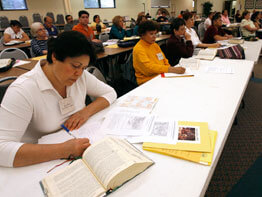WASHINGTON – These days you can get a Bible that coincides with pretty much any interest.
For the environmentally conscious, there is the Green Bible, complete with soy-based inks, recycled paper and special features that trace Scripture’s environmental themes. For the young and hip, there’s the Manga Bible, illustrated in the popular Asian comic-book style and available in versions dubbed “raw” (with commentary and instruction on the manga style) or “extreme” (with the New Testament text written out).
You can listen to “The Word of Promise,” an audiobook of the New Testament that features the voices of leading actors like Jim Caviezel, Marisa Tomei, Michael York, Richard Dreyfuss and Terence Stamp as the voice of God. There are Bibles aimed at couples, students, children, women and participants in just about every sport you can imagine – skiers, skateboarders, surfers and on and on.
But not all Bibles are created equal. And not every Bible reflects a Catholic understanding of Scripture.
Although Catholics may read any version of the Bible for their personal use, the Bible authorized for use in English-language Masses in U.S. Catholic churches is the New American Bible, for which the Confraternity of Christian Doctrine holds licensing rights. The confraternity operates out of the U.S. Conference of Catholic Bishops’ Office of Publishing.
Mary Elizabeth Sperry, associate director for USCCB permissions and New American Bible utilization, handles each request to use all or part of the NAB text, using guidelines developed by the membership of the Confraternity of Christian Doctrine. She refers any borderline requests back to the confraternity’s board of control, made up of Scripture scholars appointed by the confraternity’s president.
Requests that would be turned down are those that “interpret the Bible in a way not consonant with Catholic teaching or do not reflect the integrity of the Catholic text,” Ms. Sperry said.
The Confraternity of Christian Doctrine currently has licensing agreements with publishers of the New American Bible in Korea, India, Philippines, the U.S. and “most of Anglophone Africa,” she said, and other agreements are in the works.
The U.S. situation is rather unique because “we are one of the few publishers that controls a copyright but does not publish” a Bible itself, Ms. Sperry said.
When a new translation of the Old Testament is completed – the hoped-for date is sometime this fall – Ms. Sperry predicts “an explosion” in the licensing and publication of so-called “niche Bibles” for Catholic women, couples, youths and other groups.
“Catholics want to have the same choices that their Protestant friends have, but they want to have a Catholic text,” she said in an interview with Catholic News Service.
Catholics’ interest in the Bible still lags behind that of their Protestant counterparts, however, according to polling in recent years.
The Barna Group found in its 2006 survey of religious behaviors and beliefs that 47 percent of Americans reported reading the Bible in a typical week, outside church services. That was the highest Bible readership since the evangelical polling firm began asking the question in the 1980s.
The number had been as low as 31 percent in 1995, according to the series of surveys, which had a margin of error of plus or minus 3.2 percentage points.
But a survey this spring by LeMoyne College in Syracuse, N.Y., and Zogby International found that nearly two-thirds of adult Catholics said they never read the Bible (31.6 percent) or read it only a few times a year (31.3 percent). Only 8.4 percent said they read the Bible daily; another 14 percent said they read it at least once a week.
But Catholics may be going to sources other than the printed word for Bible reading, if the Web site of the USCCB is any indication.
In the first six months of 2008, the New American Bible page on the USCCB Web site had 8.7 million hits – 70 percent of the 12.4 million hits to the entire Web site. And podcasts of the daily Bible readings were downloaded nearly 1 million times during that period.
It’s unclear how many of those Web visitors were Catholics but an informal poll of visitors to the NAB page over two months in 2007 found that more than half of the respondents identified themselves as parishioners or parish volunteers. More than 90 percent reported attending Mass at least weekly.
Also difficult to gauge is the number of Bibles published each year and to date.
Luke Timothy Johnson, the R.W. Woodruff professor of New Testament and Christian origins at Emory University in Atlanta, has estimated that the Bible has been printed some 5 billion times since the early 1800s and translated into more than 2,000 languages.


